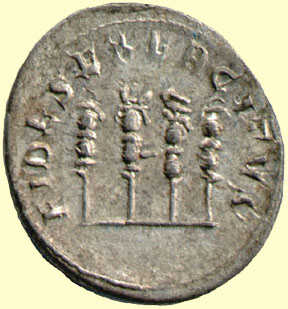 Contents -
Previous Article -
Next Article
Contents -
Previous Article -
Next Article
The Crisis of the Third Century
A. D. 235 - 284
A. D. 235 - 284
During the middle years of the Third Century, the Roman Empire went through several changes which almost destroyed it. Barbarian invasions by the Goths and other German tribes threatened the empire from the outside. Also, this was a time of almost continuous civil war. Emperors were placed on the throne by the army only to be murdered and replaced by another of the army's favorites. During the reign of Gallienus, the Roman government literally went bankrupt. Silver was removed from the coins and the resulting runaway inflation caused the financial ruin of the majority of the people. This is also a period about which there is little reliable information. Suetonius, Tacitus, Livy, Dio Cassius, and our other early sources died before this period. Ammianus Marcellinus, Claudian, Herodian, Cassiodorus, and Merobaudes lived later but either did not write about this period or their works were lost. Our main sources for information about the period are histories that were written at a much later date, inscriptions on coins, fragments of information from inscriptions on monuments and evidence from archaeological digs. The one work most often quoted that supposedly gives the history of the period is the HISTORIA AVGVSTA, or History of the Later Caesars. It is believed to be reliable for the period from the middle of the second century until about A. D. 235 but after this date much of the Historia Augusta is myth, legend, and tall tales. The mid Third Century is one of those fascinating little nooks and crannies of history that prove irresistible to some historians and around which many wonderful stories grow. After studying the period one comes to appreciate that sometimes the best and often the only history is legend, a story well-told and that this substitution of fantasy for missing fact is often the best record we have available. As we learn more about the period by putting together clues from archaeology, coins, and documents long buried in a medieval library or monastery that sometimes see the light of day, our knowledge grows and our reliance on the legends becomes less. It is a period about which an amateur scholar can actually make meaningful contributions to our overall knowledge. Most of the coins from the period are inexpensive and archaeological discoveries are sometimes made by a coin collector reading an odd bit of inscription in his or her own living room. After checking the coin against published books, occasionally a light goes on in the head of the armchair scholar with the discovery "... Why, I believe this shows that Emperor So-and-So actually DID perform this deed at that particular time!"
Go to next article:
Go back to previous article:
Return to Late Roman Empire Table of Contents
 Contents -
Previous Article -
Next Article
Contents -
Previous Article -
Next Article